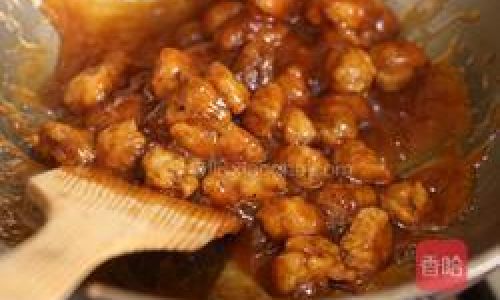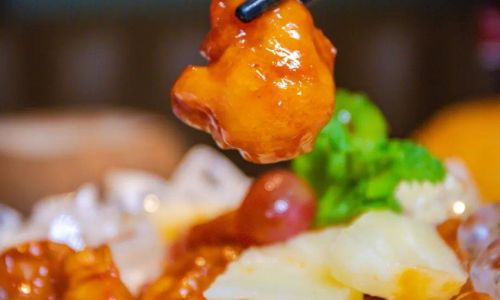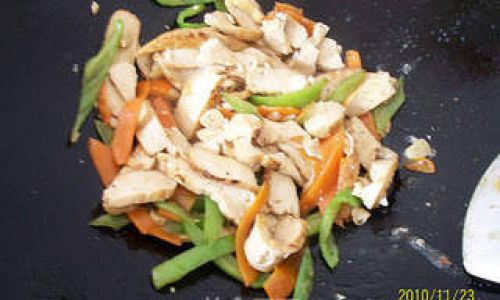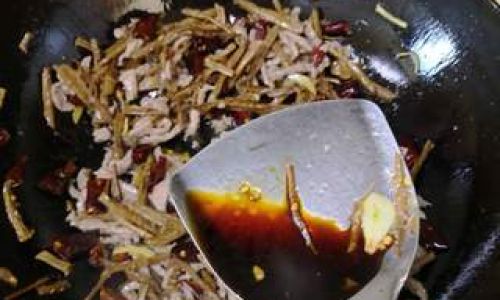Introduction
Chilled sweet and sour pork, a delightful twist on the classic Chinese-American takeout favorite, offers a refreshing escape from the traditional warm, saucy presentation. This dish transforms crispy fried pork pieces into a cool, tangy-sweet masterpiece, perfect for summer gatherings, picnics, or any occasion calling for a burst of vibrant flavor. Unlike its hot counterpart, which relies on a thick, glossy sauce coating each piece, the chilled version marries texture and temperature to create a unique culinary experience. The pork retains its crunch even when cooled, while the sauce evolves into a glossy, chilled glaze that clings lightly to the meat. This recipe demands precision in frying, balance in seasoning, and patience in chilling—but the result is a dish that will impress even the most discerning palates.
The Philosophy Behind Chilled Sweet and Sour Pork

At its core, this dish is a study in contrasts: hot vs. cold, crispy vs. tender, sweet vs. tangy. The magic lies in how these elements harmonize. Chilling the pork after frying ensures the coating remains crisp, while the sauce—reduced and cooled—becomes a viscous, flavorful companion rather than a heavy coating. The dish also invites creativity; feel free to adjust sweetness, acidity, or spice levels to suit your taste. Whether served as an appetizer, main course, or party platter centerpiece, chilled sweet and sour pork is a testament to the versatility of Asian-inspired cuisine.
Ingredients: Assembling Your Culinary Arsenal
To embark on this culinary adventure, gather the following ingredients, organized into categories for clarity:
For the Pork:
- 1 lb (450g) pork tenderloin or shoulder, cut into 1-inch cubes
- 1 tsp salt
- 1 tsp white pepper
- 1 tbsp Shaoxing wine (or dry sherry)
- 1 tbsp cornstarch
For the Batter:
- 1 cup (125g) all-purpose flour
- 1/4 cup (30g) cornstarch
- 1 tsp baking powder
- 1/2 tsp salt
- 1 cup (240ml) ice-cold water (or sparkling water for extra crispiness)
- 1 egg, beaten
For the Sweet and Sour Sauce:
- 1/2 cup (120ml) pineapple juice (fresh or canned)
- 1/4 cup (60ml) rice vinegar
- 1/4 cup (50g) granulated sugar
- 2 tbsp ketchup
- 1 tbsp soy sauce
- 1 tsp cornstarch (dissolved in 1 tbsp water)
- 1/2 red bell pepper, diced
- 1/2 green bell pepper, diced
- 1/2 small onion, diced
- 1/2 cup (75g) pineapple chunks (fresh or canned)
- 1 tbsp vegetable oil
For Garnish and Assembly:
- 1/4 cup fresh cilantro, chopped
- 1 tbsp toasted sesame seeds
- 1/2 tsp red pepper flakes (optional)
- Iceberg lettuce leaves (for serving)
Equipment Checklist:
- Deep fryer or heavy-bottomed pot
- Candy thermometer
- Mixing bowls
- Whisk
- Slotted spoon
- Paper towels
- Baking sheet
- Wire rack
- Saucepan
The Method: Step-by-Step Mastery
Preparing the Pork

Begin by marinating the pork to infuse it with flavor and tenderize the meat. In a medium bowl, combine the pork cubes, salt, white pepper, Shaoxing wine, and cornstarch. Toss gently until each piece is evenly coated. Cover the bowl with plastic wrap and refrigerate for at least 30 minutes (or up to 2 hours). This step ensures the meat remains juicy and seasoned throughout.
Crafting the Perfect Batter
The batter is the soul of this dish’s crunch. In a large mixing bowl, whisk together the flour, cornstarch, baking powder, and salt. Create a well in the center and pour in the ice-cold water and beaten egg. Gently stir until just combined—lumps are okay, but avoid overmixing, as this will make the batter tough. The cold temperature is crucial; it minimizes gluten development, ensuring a light, airy coating. For an even crispier texture, substitute the water with chilled sparkling water.
Frying the Pork: The Golden Crunch
Heat 4 cups (1 liter) of vegetable oil in a deep fryer or heavy-bottomed pot to 350°F (175°C). Use a candy thermometer to monitor the temperature accurately.
Working in batches to avoid overcrowding, dip each marinated pork cube into the batter, ensuring full coverage. Carefully lower the pieces into the hot oil, frying for 4-5 minutes until golden brown. Use a slotted spoon to transfer the cooked pork to a wire rack placed over a baking sheet. This setup allows excess oil to drain while maintaining crispiness.
Pro Tip: For ultra-crispy pork, perform a double fry. After the initial frying, let the oil return to 350°F and fry the pork again for 1-2 minutes. This technique locks in crunchiness.
Preparing the Sweet and Sour Sauce
While the pork fries, prepare the sauce. In a saucepan, heat 1 tbsp vegetable oil over medium heat. Add the diced bell peppers and onion, sautéing until slightly softened (2-3 minutes). Stir in the pineapple juice, rice vinegar, sugar, ketchup, and soy sauce. Bring the mixture to a simmer, then whisk in the cornstarch slurry. Continue cooking until the sauce thickens to a syrupy consistency (2-3 minutes). Remove from heat and fold in the pineapple chunks. Let the sauce cool to room temperature before refrigerating.
Assembling the Dish: The Chill Factor

Once the pork is fried and the sauce cooled, combine them. Place the fried pork in a large mixing bowl and pour half the sauce over it. Gently toss to coat, ensuring each piece is lightly dressed. Transfer the pork to a shallow dish, cover, and refrigerate for at least 2 hours (or overnight). This chilling period allows the flavors to meld and the sauce to set into a glossy glaze.
Final Touches: Presentation and Garnish
Just before serving, remove the pork from the refrigerator. Arrange iceberg lettuce leaves on a serving platter. Top with the chilled pork, drizzling any remaining sauce over the pieces. Sprinkle with fresh cilantro, toasted sesame seeds, and red pepper flakes for a pop of color and heat.
Serving Suggestions: Beyond the Basics
Chilled sweet and sour pork shines as a standalone dish but pairs beautifully with accompaniments. Serve it over a bed of jasmine rice or alongside steamed dumplings for a heartier meal. For a low-carb option, use shredded cabbage or cucumber ribbons as a base. The dish also complements light beverages like iced green tea, lemonade, or a crisp lager.
Pro Tips for Perfection
- Oil Temperature: Maintaining consistent oil heat is critical. If the oil is too hot, the batter will burn before the pork cooks; too cool, and the coating will absorb grease.
- Batter Consistency: The batter should cling to the pork without dripping. If it’s too thick, add a splash of cold water; if too thin, sprinkle in a bit more flour.
- Sauce Sweetness: Adjust the sugar-to-vinegar ratio to taste. For a tangier profile, increase the vinegar; for sweetness, add a touch more pineapple juice or honey.
- Make-Ahead Convenience: The pork and sauce can be prepared a day in advance. Store them separately and assemble just before serving to preserve texture.
Variations and Innovations
- Spicy Kick: Add minced garlic or ginger to the sauce, or garnish with sliced jalapeños.
- Vegetarian Twist: Substitute the pork with crispy fried tofu or tempeh. Adjust marinating time accordingly.
- Fruit Infusions: Experiment with mango, kiwi, or mandarin oranges in the sauce for tropical flair.
- Gluten-Free Option: Use rice flour in the batter and tamari instead of soy sauce.
Troubleshooting Common Issues
- Soggy Coating: Ensure the oil is hot enough before frying, and avoid overcrowding the pot. Double-frying also helps.
- Bland Flavor: Marinate the pork longer next time, or increase the seasoning in the batter.
- Too Sweet/Sour: Balance the sauce by adding more vinegar (if too sweet) or sugar (if too tart).
The Science of Chilling: Why It Works
Chilling the pork after frying serves two purposes: it halts the cooking process, preventing overcooking, and allows the starches in the batter to set, locking in crispiness. The sauce, when cooled, thickens further due to the cornstarch’s gelatinization, creating a sticky glaze rather than a runny coating. This texture contrast is key to the dish’s appeal.

Cultural Context: A Fusion Story
Sweet and sour pork’s origins trace back to 18th-century China, where it was a humble dish of fried meat with a simple vinegar-sugar glaze. The version we know today evolved in North America, adapted for Western palates with the addition of pineapple and bell peppers. The chilled iteration is a modern innovation, reflecting a growing preference for lighter, refreshing dishes in warmer climates.
Health Considerations
While fried foods are indulgent, this recipe uses lean pork tenderloin and a relatively light batter. For a healthier twist, bake the pork at 400°F (200°C) for 20-25 minutes instead of frying. Opt for low-sodium soy sauce and reduce the sugar by half, compensating with natural sweeteners like apple juice or stevia.
Conclusion: A Culinary Triumph Awaits
Chilled sweet and sour pork is more than a recipe—it’s a celebration of balance, texture, and temperature. By mastering each step, from marinating to chilling, you’ll create a dish that delights the senses and invites conversation. Whether you’re hosting a backyard barbecue or simply craving a taste of culinary adventure, this recipe promises to elevate your cooking repertoire. So, fire up the fryer, chill that sauce, and prepare to savor the sweet, sour, and utterly satisfying results. Your guests (and your taste buds) will thank you.






0 comments